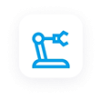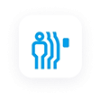The robotic industry is heavily vested in sensor technologies as these sensing devices enable robots to understand and learn things about the environment they are operating within. Due to their critical importance, there are businesses and institutions that conduct active research to design and develop advanced sensors to push the sensing technology further.
Research & Development (R&D) and HigherEd are the two sectors that play a crucial role in bringing the latest sensor technologies and transforming the robotics industry. Let’s find out how these two sectors contribute to building advanced sensors for the robots of today and tomorrow.
Research and Development in Sensor Technologies
Today’s sensors are vastly different from the ones ten years back. These devices have considerably gotten smaller, more powerful, and better at sensing. Much of these advancements are because of the research and development happening globally.
In the robotics industry, sensor size, weight, and power consumption are critical factors that determine the robot’s efficiency. Sensors becoming smaller and more efficient is always good news, as it means the robot needs to carry less weight and perform better at its tasks while consuming less energy.
Recently, the State House of Massachusetts awarded Harvard and Boston University a grant of $3 million for Assistive Robotics and Wearable Technology Research. This project aims to boost the commercialization of wearable and med-tech devices. The research hopes to create devices that will improve people’s lives with neuro-motor impairments and develop wearable tech that helps people track their health.
However, this is only one of the examples worldwide where active investments are happening in robotics research and development.
Enabling robots to see their environment
One of the most significant challenges in robots is to develop a technology that enables robots to see and feel their surroundings. Only then can we create robots that respond to their environment.
Imaging sensors coupled with software techs like AI and Machine Learning are turning this concept into a reality. While imaging sensors send pictures of the surroundings to the CPU, sensors like LiDAR and proximity sensors enable the robot to calculate distances, detect obstacles and compute whether it can safely pass through the given space.
The type of sensors fitted to any robotic system varies based on its design and purpose. For instance, a Tesla car consists of 8 image sensors, 12 ultrasonic sensors, and a forward-facing radar to detect objects in front of it. Similarly, the Spot from Boston dynamics uses stereo and depth cameras, inertia sensors, and force sensors to perform the tasks it is designed for.
Microsensors for micro-robots
Microsensors are a reality now and an area of active research. These micro-sized sensing devices work at a Nano-scale level and can relay information to the processing unit. However, research and development in microsensors have specific challenges, like identifying a solution to dissipate heat generated from the circuitry.
Irrespective of the challenges, the applications of microsensors are vast. These tiny sensors can enable robots to have many sensing capabilities without adding additional weight or consuming more power. Microsensors will also push the development of miniature robots that can serve specialized purposes in the fields of medicine and microbiology.
Smart sensors for the future
Sensors, currently, are in a state of transition where they are designed to do more than just relay information and perform intelligent actions, like doing logic operations on their own. Such smart capabilities are meant to reduce the load on control systems and make the entire system more efficient and easier to manage. Moreover, computations at a sensor level translate to faster decision-making, thereby reducing response time.
Sensors in HigherEd Classes
The drivers of tomorrow’s technology are the young enthusiasts of today. Higher Education plays a critical role in introducing new technologies to young minds. Mass production of sensors has made it easier for students to access high-performance sensing devices within an affordable price range for their innovative robotics projects.
Sensor technologies are now being added to curriculums to help students familiarize themselves with the technology and start their own experimentation. Universities are also setting up projects and assignments specifically for robotics. For instance, researchers at the University of Chicago were able to come up with stretchable pressure sensors that could help accelerate the development of soft robotic hands.
In addition, competitions like LEGO League aim to bring young minds to the world of robotics and help them build innovative robotics applications.
Get Top-Quality Sensors from Hokuyo
With sensors being an indispensable part of any robotics project, it is essential to have access to the best components. At Hokuyo, we make high-quality sensors for enthusiasts and industries alike. Contact us to know more about how our sensors can help you build your next autonomous robotics application.

 Factory Automation
Factory Automation Logistics Automation
Logistics Automation Process Automation
Process Automation Crane Collision Avoidance
Crane Collision Avoidance LiDAR Sensors
LiDAR Sensors Safety Laser Scanners
Safety Laser Scanners Optical Data Transmission
Optical Data Transmission Hot Metal Detectors
Hot Metal Detectors Laser Distance Sensor
Laser Distance Sensor Blog
Blog Whitepapers
Whitepapers Case Studies
Case Studies Infographics
Infographics